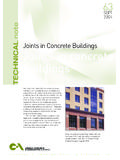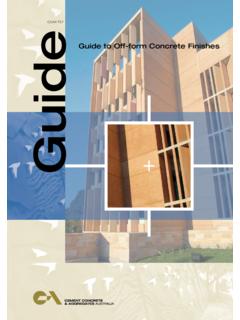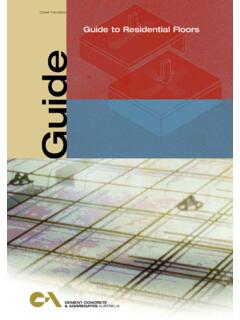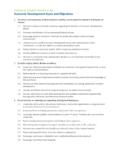Transcription of Guide
1 CONCRETE BASICS A Guide to Concrete PracticeGuideMORE InformationCement Concrete & Aggregates Australia is committed to being the major source of information on cement, concrete and aggregates in Australia. For a complete listing of all retail and free publications please visit and bookmark CCAA website Concrete & Aggregates Australia is a not-for-profit organisation established in 1928 and committed to serving the Australian construction is acknowledged nationally and internationally as Australia's foremost cement and concrete information body taking a leading role in education and training, research and development, technical information and advisory services, and being a significant contributor to the preparation of Codes and Standards affecting building and building 's principal aims are to protect and extend the uses of cement, concrete and aggregates by advancing knowledge.
2 Skill and professionalism in Australian concrete construction and by promoting continual awareness of products, their energy-efficient properties and their uses, and of the contribution the industry makes towards a better Concrete & Aggregates Australia ABN 34 000 020 486 CCAA OFFICESSYDNEY OFFICE:Level 6, 504 Pacific Highway St Leonards NSW Australia 2065 POSTAL ADDRESS: Locked Bag 2010 St Leonards NSW 1590 TELEPHONE: (61 2) 9437 9711 FACSIMILE: (61 2) 9437 9470 BRISBANE OFFICE: Suite 2, Level 2, 485 Ipswich Road Annerley QLD 4103 TELEPHONE: (61 7) 3227 5200 FACSIMILE: (61 7) 3892 5655 MELBOURNE OFFICE:2nd Floor, 1 Hobson Street South Yarra VIC 3141 TELEPHONE: (61 3) 9825 0200 FACSIMILE: (61 3) 9825 0222 PERTH OFFICE:45 Ventnor Avenue West Perth WA 6005 TELEPHONE: (61 8) 9389 4452 FACSIMILE: (61 8) 9389 4451 ADELAIDE OFFICE:PO Box 229 Fullarton SA 5063 TELEPHONE: (61 8) 8274 3758 PREMIXED CONCRETE AND EXTRACTIVE INDUSTRIES OFFICEPO Box 243 Henley Beach SA 5022 TELEPHONE: (61 8) 8243 2505 FACSIMILE: (61 8) 8125 5822 TASMANIAN OFFICE: PO Box 246 Sheffield TAS 7306 TELEPHONE: (61 3) 6491 1509 FACSIMILE: (61 3) 6491 2529 WEBSITE.
3 Concrete & Aggregates Australia1 Concrete Basics Concrete Materials1 CONCRETE BASICS A Guide to Concrete PracticeCONTENTSP reface page 2 CHAPTER 1 Concrete Materials pages 3 5 CHAPTER 2 Concrete Properties pages 6 9 CHAPTER 3 Concrete Testing pages 10 13 CHAPTER 4 Ordering page 14 CHAPTER 5 Proportioning and Mixing pages 15 16 CHAPTER 6 Planning and Site Preparation pages 17 19 CHAPTER 7 Transporting and Placing pages 20 22 CHAPTER 8 Compacting pages 23 25 CHAPTER 9 Finishing pages 26 27 CHAPTER 10 Curing pages 28 30 CHAPTER 11 Joints pages 31 33 CHAPTER 12 Hot and Cold Weather Concreting pages 34 35 CHAPTER 13 Colouring and Surface Finishes pages 36 39 CHAPTER 14 Defects pages 40 43 CHAPTER 15 Removing Stains pages 44 46 CHAPTER 16 Cracking pages 47 49 CHAPTER 17 Reinforced Concrete pages 50 52 CHAPTER 18 Formwork pages 53 54 Cement Concrete & Aggregates AustraliaCement Concrete & Aggregates Australia is a not for profit organisation sponsored by the cement concrete and aggregate industries in Australia to provide information on the many uses of cement and concrete.
4 This publication is produced by CCAA for that purpose. Since the information provided is intended for general guidance only and in no way replaces the services of professional consultants on particular projects, no legal liability can be accepted by CCAA for its Published July 1991 Second Edition 1992 Third Edition 1994 Fourth Edition 1996 Fifth Edition October 2002 Sixth Edition August 2004 Seventh Edition February 2010 Cement Concrete & Aggregates Australia2 CONTENTS2 Concrete Basics PrefacePrefaceCommunities around the world rely on concrete as a safe, strong and simple building material. It is used in all types of buildings (from residential to multi-storey office blocks) and in infrastructure projects (roads, bridges, etc).Despite its widespsread use, many people are unaware of the considerations involved in providing high quality, strong, durable Basics provides a clear, concise explanation of all aspects of making quality concrete; from the Materials and Properties involved through Planning, Preparation, Finishing and Basics addresses the needs of unskilled and semi-skilled persons undertaking general concreting projects including home and handyman projects.
5 Concrete Basics also assists owner builders in the supervision of construction. It aims to develop an understanding of technical terms through clear definition accompanied by simple illustrations. A general understanding of these terms will help to facilitate communication within the building Basics will help to generate a higher standard of workmanship on site and facilitate better communication among construction workers, builders, engineers, building surveyors, architects and anyone interested in understanding the processes involved in making quality Concrete & Aggregates Australia3 CONTENTSC oncrete Basics Concrete Materials3 CHAPTER 1 Concrete MaterialsCONCRETE is made by mixing:CEMENTWATERCOARSE AND FINE AGGREGATESADMIXTURES (if required).The aim is to mix these materials in measured amounts to make concrete that is easy to:TRANSPORTPLACECOMPACTFINISHand which will set, and harden, to give a strong and durable relative amount of each material (ie cement, water and aggregates) affects the properties of CHAPTER 2 Concrete PropertiesCEMENT The cement powder, when mixed with water, forms a paste acts like glue and holds or bonds the aggregates major types of cement are sold in Australia.
6 Type GP (General Purpose Portland cement)Type GB (General Purpose Blended cement)Type HE (High Early Strength cement)Type LH (Low Heat cement)Type SR (Sulfate Resisting cement)Type SL (Shrinkage Limited cement)Each type of cement will produce concrete with different most commonly used are Type GP and Type cements contain portland cement and more than 5% of either fly ash, ground slag, amorphous silica (eg silica fume), or a combination of 80% of mix volumeWATERCEMENTC ement Concrete & Aggregates Australia4 CONTENTSC oncrete Basics Concrete Materials4 STORAGE Cement should be stored off the ground in a well-aired, clean, dry the cement bags in plastic sheets gives extra cement will normally be stored in Aggregates are of two basic types:COARSE: crushed rock, gravel or : fine and coarse sands and crusher fines.
7 Sand should be concreting sand and not brickies sand or plasterers should be:STRONG and HARD so as to give a strong final concrete crumbly or flakey rock such as sandstone should not be to stand up to wear and tear and INACTIVE so that the aggregates don t react with the since dirt or clay sticking to the aggregates will weaken the bond between paste and be of a range of sizes so that they fit together well to give a strong and dense aggregates give a more workable mix. Angular aggregates make concrete harder to place, work and compact, but can make concrete Aggregates should be stored where they will remain clean, separated from other materials and dry. If the aggregates are wet, less water should be used in the Concrete & Aggregates Australia5 CONTENTSC oncrete Basics Concrete Materials5 WATER Water is mixed with the cement powder to form a paste which holds the aggregates together like must be clean, fresh and free from any dirt, unwanted chemicals or rubbish that may affect concrete plants now use recycled check bore water before t use sea water in reinforced concrete as it may rust the reinforcing Admixtures are mixed into the concrete to change or alter its properties, ie the time concrete takes to set and harden, or its THE PROCESS WORKS Measured amounts of the coarse and fine aggregates are mixed measured amount of cement is added and mixed water is added to make the mix workable.
8 All the materials are then mixed together well. The cement powder and water form a paste which acts like a glue to bond the aggregates Concrete & Aggregates Australia6 CONTENTS6 Concrete Basics Concrete PropertiesCHAPTER 2 Concrete PropertiesThe Properties of Concrete are its characteristics or basic has three different states:PLASTICSETTINGHARDENEDC oncrete has different properties in each state. The four main properties of concrete are:WORKABILITYCOHESIVENESSSTRENGTH andDURABILITYPLASTIC STATE When the concrete is first mixed it is like 'bread dough'. It is soft and can be worked or moulded into different shapes. In this state concrete is called PLASTIC. Concrete is plastic during placing and most important properties of plastic concrete are workability and worker will sink into plastic STATE Concrete then begins to stiffen.
9 The stiffening of concrete, when it is no longer soft, is called SETTING. Setting takes place after compaction and during that is sloppy or wet may be easy to place but will be more difficult to worker leaves footprints in setting STATE After concrete has set it begins to gain strength and harden. The properties of hardened concrete are strength and concrete will have no footprints on it if walked Concrete & Aggregates Australia7 CONTENTS7 Concrete Basics Concrete PropertiesWORKABILITY Workability means how easy it is to:PLACEHANDLECOMPACT andFINISH the that is stiff or dry may be difficult to handle, place, compact and finish and, if not constructed properly, will not be as strong or durable when finally hardened. A slump test can be used to measure the workability of CHAPTER 3 Concrete TestingWorkability is affected by:THE AMOUNT OF CEMENT PASTEThe cement paste is the soft or liquid part of the concrete mix.
10 The more paste mixed with the coarse and fine aggregates, the more workable a aggregate PROPERTIES AND GRADINGWell-graded, smooth, rounded aggregates improve the workability of a aggregate Grading under make a more workable mix:Add more CEMENT WELL GRADED an ADMIXTURE (admixtures that improve workability are known as plasticisers).Never try to make a mixture more workable by just adding more water because this lowers the strength and durability of Concrete & Aggregates Australia8 CONTENTS8 Concrete Basics Concrete PropertiesCOHESIVENESS Cohesiveness is how well concrete HOLDS TOGETHER when is affected by:THE aggregate GRADINGG raded aggregate means that there is a range of size of aggregates, from large rocks to small sands. Well-graded aggregates give a more cohesive mix, too much coarse aggregate gives a boney CONTENTA mix that has too much water will not be cohesive and may allow materials to separate (segregate).











